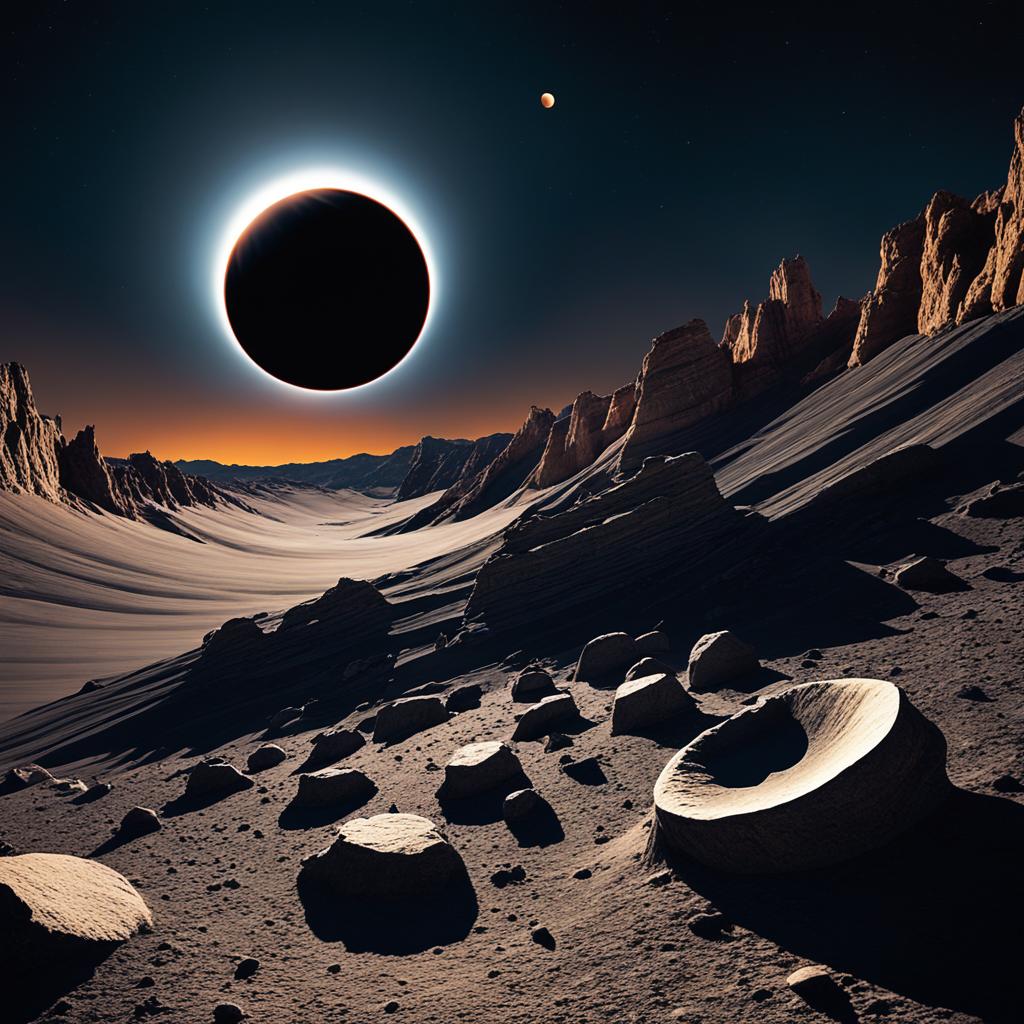Advertisements
Eclipses are fascinating astronomical phenomena that occur when a star is temporarily hidden due to the presence of another celestial body or the interposition of a shadow. The two main types of eclipses they are the solar eclipses and the lunar eclipses. They occur when the Sun, Moon and Earth align in certain positions. You solar eclipses occur when the Moon is positioned between the Sun and the Earth, partially or completely blocking sunlight. Already the lunar eclipses occur when the Earth is positioned between the Sun and the Moon, projecting its shadow on the natural satellite. In addition to these types, there are variations such as eclipses annular and hybrids. Eclipses are rare events and arouse the curiosity and excitement of people around the world.
Key Takeaways
- Eclipses are fascinating astronomical phenomena that arouse curiosity and excitement
- There are two main types of eclipses: solar eclipses It is lunar eclipses
- Solar eclipses occur when the moon blocks some or all of the sunlight
- Lunar eclipses occur when the Earth's shadow covers the Moon
- There are also variations such as annular and hybrid eclipses.
- Eclipses are rare events and provide a unique experience for observers
Types of Solar Eclipses

Solar eclipses are fascinating astronomical events that arouse the curiosity and enchantment of observers around the world. These celestial phenomena occur when the Moon is positioned between the Sun and the Earth, partially or completely blocking sunlight. There are four main types of solar eclipses, each providing a unique and special experience for those privileged to witness them.
Advertisements
Total Solar Eclipse
At the total solar eclipse, the Moon completely blocks sunlight, creating a spectacular scene where only the Sun's corona is visible around the lunar silhouette. During this type of eclipse, the darkness and luminous aura surrounding the Moon offer a stunning view of the cosmos in action.
Partial Solar Eclipse
Already in partial solar eclipse, the Moon covers only part of the solar disk, allowing some of the Sun's light to be visible. This interaction between celestial bodies provides a unique atmosphere and an opportunity to appreciate the contrast between partial darkness and the bright light of the Sun.
Advertisements
Annular Solar Eclipse
O annular solar eclipse is an extraordinary phenomenon that occurs when the Moon is furthest from Earth in its elliptical orbit. In this type of eclipse, the Moon cannot completely cover the Sun, leaving a bright ring around the star. This “ring of fire” effect provides a visually stunning experience for privileged observers.
Hybrid Solar Eclipse
The hybrid solar eclipse is a phenomenon that combines characteristics of total and partial solar eclipses. Depending on the curvature of the Earth and the location of the observer, the eclipse may be observed as total in some areas and partial in others. This unique combination offers different perspectives and views of the celestial spectacle.
Solar eclipses are rare and special moments that allow us to witness the grandeur of the universe. These different types of eclipses solar systems provide not only scientific knowledge, but also an opportunity to connect with the cosmos. Prepare for upcoming solar eclipses and immerse yourself in the stunning beauty of these spectacular astronomical events.
Types of Lunar Eclipses
Just like solar eclipses, lunar eclipses also come in different types. Let's explore each of them:
See too:
Total Lunar Eclipse
O total lunar eclipse occurs when the Moon is completely immersed in the Earth's shadow, acquiring a reddish hue known as the “Blood Moon”. During this phenomenon, the Moon becomes a surprising spectacle, shrouded in mystery and beauty.
Partial Lunar Eclipse
At the partial lunar eclipse, only a part of the lunar disk is covered by the Earth's shadow. In this type of eclipse, it is possible to observe the interaction between different intensities of light and shadow, creating a charming and intriguing visual effect.
Penumbral Lunar Eclipse
The penumbral lunar eclipse is more subtle and difficult to detect. It occurs when the Moon passes through the penumbra of the Earth's shadow, causing a slight decrease in its luminosity without the Moon being completely darkened. Although it is less dramatic than total and partial lunar eclipses, it still offers a unique visual spectacle for nighttime observers.
The different types of eclipses Lunar moons provide unique moments of contemplation and admiration for our celestial world. Now that we understand a little more about the types of eclipses lunar, let's explore the occurrence of these phenomena in Brazil.
| Type of Lunar Eclipse | Characteristics |
|---|---|
| Total Lunar Eclipse | Moon completely immersed in Earth's shadow; reddish hue (Blood Moon) |
| Partial Lunar Eclipse | Part of the lunar disk covered by the Earth's shadow; contrasts of light and shadow |
| Penumbral Lunar Eclipse | Slight decrease in lunar luminosity; passage through the twilight of the Earth's shadow |
Occurrence of eclipses in Brazil
Brazil is privileged to observe some eclipses over the years. Although not all eclipses are visible throughout Brazil, the country can witness some of these celestial phenomena. For example, the annular solar eclipse which will take place on October 14, 2023 will be visible in some areas of the North and Northeast regions of Brazil, while in other regions of the country it will be possible to observe only a partial solar eclipse. It is important to be aware of upcoming eclipses so as not to miss the opportunity to witness these rare and exciting events.
Conclusion
Eclipses continue to be a source of fascination and excitement for observers around the world. These rare astronomical phenomena provide a unique experience, allowing people to witness the power and beauty of the universe. Whether observing a solar or lunar eclipse, we are captivated by the contrast of celestial lights and shadows.
Therefore, don't miss the opportunity to marvel at this cosmic spectacle and unravel the mysteries of eclipses. As we prepare for upcoming eclipses, we dive head first into the fascinating world of astronomy. By eclipse observation experience, we can feel how small we are in the face of the vast cosmos and realize the connection between our planet and the infinite universe.
When we appreciate the magnitude of the phenomenon, it is impossible not to be captivated by its magnitude and complexity. After all, eclipses show us that, no matter how advanced we are, there is still much to be explored and understood in relation to the cosmos. Eclipses encourage us to seek knowledge, question and admire the wonders of the world around us.
FAQ
What are eclipses?
Eclipses are astronomical phenomena that occur when a star becomes temporarily hidden due to the presence of another celestial body or the interposition of a shadow.
What are the main types of eclipses?
The main types of eclipses are solar eclipses and lunar eclipses.
What is a solar eclipse?
A solar eclipse occurs when the Moon positions itself between the Sun and the Earth, partially or completely blocking sunlight.
What is a lunar eclipse?
A lunar eclipse occurs when the Earth positions itself between the Sun and the Moon, casting its shadow on the natural satellite.
What are the types of solar eclipse?
You types of solar eclipse they are: total solar eclipse, partial solar eclipse, annular solar eclipse It is hybrid solar eclipse.
What are the types of lunar eclipses?
You types of lunar eclipse they are: total lunar eclipse, partial lunar eclipse It is penumbral lunar eclipse.
Where will the next eclipses occur in Brazil?
We will let you know when they will occur eclipses in Brazil over the years, but not all eclipses will be visible throughout Brazil.
What is the visibility of eclipses in Brazil?
On October 14, 2023, it will be possible to observe an annular solar eclipse in some areas of the North and Northeast regions of Brazil, while in other regions of the country only a partial solar eclipse will be visible.
Why are eclipses rare events?
Eclipses are rare events because they require a specific position of alignment between the Sun, Moon and Earth.
What makes eclipses fascinating?
Eclipses are fascinating due to the contrast between celestial lights and shadows, providing a unique experience for observers.
